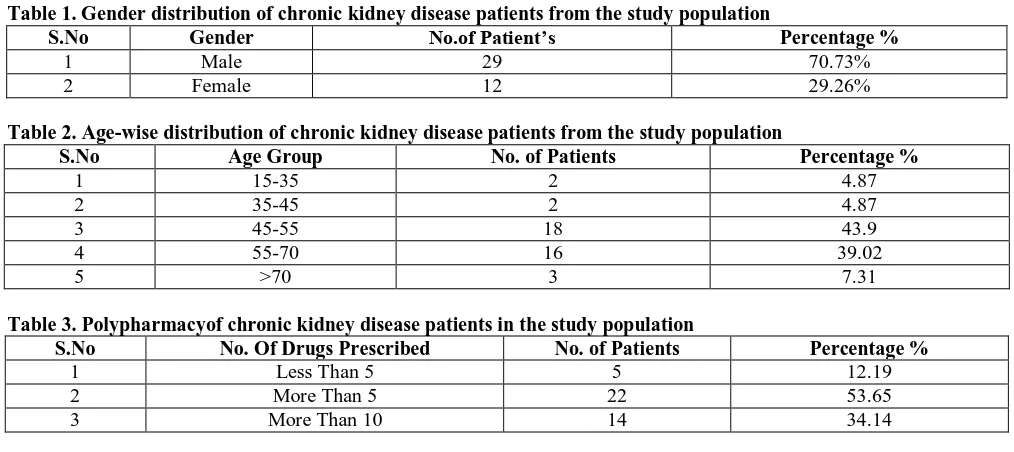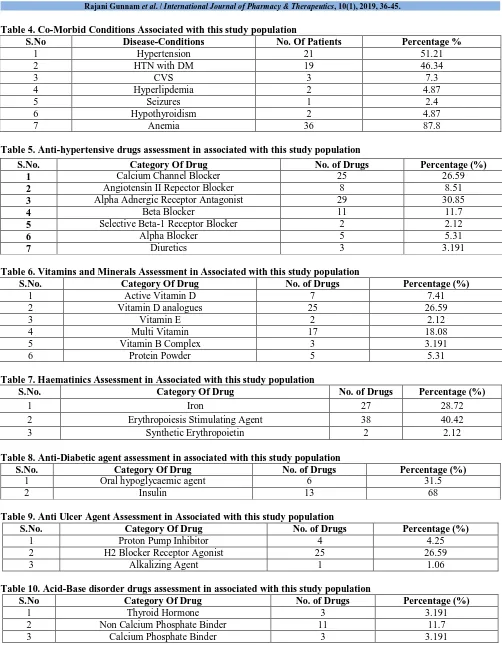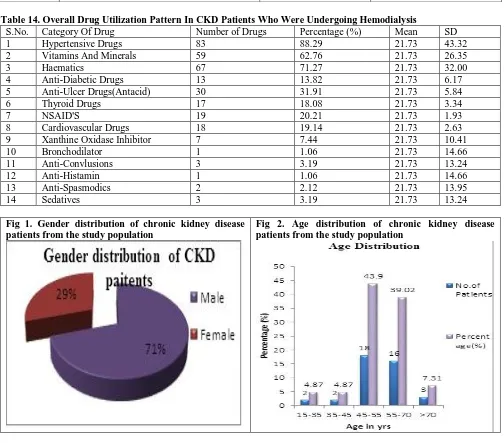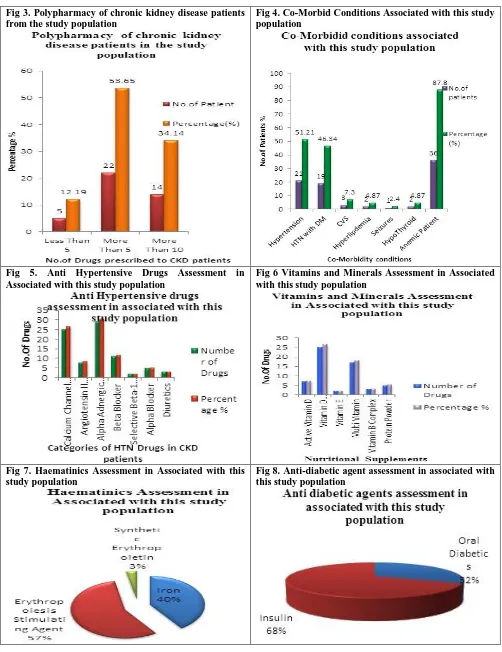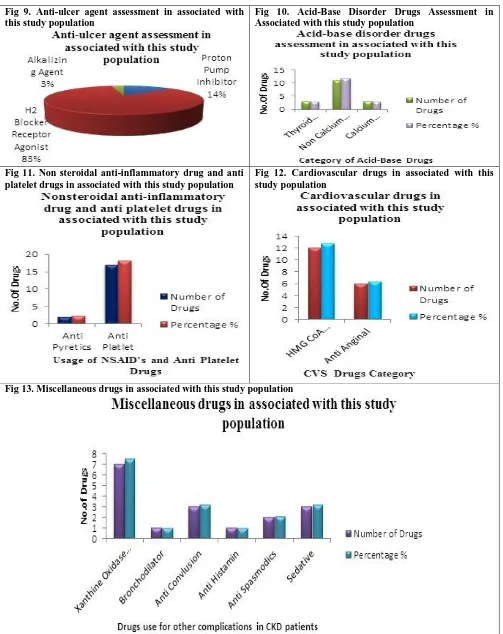36 | P a g e
e- ISSN 0976-0342 Print ISSN 2229-7456
International Journal of Pharmacy & Therapeutics
Journal homepage: www.ijptjournal.com
A PROSPECTIVE STUDY ON DRUG UTILIZATION PATTERN OF
CHRONIC
KIDNEY
DISEASE
PATIENTS
UNDERGOING
HAEMODIALYSIS
Rajani Gunnam
1*, Shaik Banu Tahrunnisa
1, Archana Pabba
1, E.Alice Melinda
1, G
Nagarjuna Reddy
2, M.Dhanalakshmi
21
Department of Pharmacy Practice, KLR Pharmacy College, Paloncha, Kothagudem, Telangana, India.
2
Department of Pharmaceutical Analysis, KLR Pharmacy College, Paloncha, Kothagudem, Telangana, India.
ABSTRACT
The aim of the present study is to analyze the drug utilization pattern in chronic kidney disease patients who was undergoing hemodialysis. To study and describe the drug utilization pattern of assorted categories of medication together with high blood pressure, DM, and different co-morbid conditions in patients with chronic kidney disease (CKD). A prospective, observational and descriptive study was conducted for a period of six months. A total of 41 subjects were included in the study aged between 18 to above 70 years and data was collected and assessed for drug prescription pattern and its categories. Among 41 patients, number of males patients (29 patients, 70.73%) and female patients (12 patients, 29.26%). A total of 94 drugs were prescribed to 41 patients who were part of the study. Each patient received an average of 7.5 drugs. Most of the patients were in the age group of 45-55 years (18 patients, 43.9%) with a mean age of 55.17 ±10.02 years. Anemia was the most common hematological manifestation observed in our study population which affected 36 patients (87.8%). Hypertension has been reported to occur in 80% to 90% of patients with Chronic Kidney Disease. This study results shows that the overall drug utilization pattern of chronic kidney disease shows higher utilization of drugs were hypertensive drugs (83 prescriptions, 88.29%),followed by anti-anemic drugs (67 prescriptions,71.27%), vitamins and minerals (59 prescriptions,62.76%), antiulcer drugs (30 prescriptions,31.91%) were most frequently used . In conclusion, it has been found that the management of chronic kidney disease in nephrology department of Singareni Collieries Company Limited, Main hospital, is with the rational utilization of medicines which is based on clinical knowledge, expertise and the guidelines accessible in the field of nephrology practice.
Key Words:-Chronic Kidney Disease, Drug Utilization Pattern, Hemodialysis.
Access this article online
Home page: http://ijptjournal.com/
DOI:
http://dx.doi.org/10.21276/ijpt.2019.10.1.6
Quick Response code
Received:29.10.18 Revised:12.11.18 Accepted:21.11.18
Corresponding Author Rajani Gunnam
Department of Pharmacy Practice, KLR Pharmacy College, Paloncha, Kothagudem, Telangana, India.
Email:- rajani.manne88@gmail.com
INTRODUCTION
Drug Utilization Pattern is outlined because the use of medication within the society with special stress on the ensuing medical, social and economic consequences and this covers the extent and profiles of drug use and therefore the trends in drug use and prices over time. Drug utilization study is described as “the marketing, distribution, prescription and utilization of drugs in the society, with special attention to the resulting medical, social and economic consequences” and has the main objective of facilitating the rational use of drugs which is very important in decision making for healthcare set up (Shalini S, Ravichandran V, 2010).
Frequent adjustments in medications during dialysis days, unstable nature of the disease, restricted
37 | P a g e
life styles and prescription of huge number of medications make these patients at high risk for developing adverse drug events due to drug-drug interactions, suboptimal action and non-adherence to treatment plans (Rama M, Viswanathan G, 2012). Chronic renal Failure (CRF) could be a worldwide public health problem with an increasing incidence and prevalence, poor outcomes and high value of treatment due to co-morbidities and Polypharmacy (Kappel J, Calissi P, 2002). Drug utilization studies might use to evaluate the drug use at a population level, per demographic, morbidity and different characteristics. These studies are helpful to observe the pattern of medication from particular therapeutic categories wherever the issues can be anticipated (Mann JF, Gerstein HC, 2001). To explain these problems, the study was planned to assess drug utilization pattern of patients with chronic kidney failure.
MATERIALS AND METHODS
This study was conducted for a period of six months from December 2017 to May 2018 in Nephroplus, Singareni Collieries Company Limited, Main Hospital, Kothagudem, Kothagudem-Bhadradri district. This study is a prospective, observational and descriptive study.
Subjects: Patients with Chronic Kidney Disease receiving hemodialysis.
Sample Size: A total of 41 chronic kidney disease patients on hemodialysis were enrolled during the study period.
Study Criteria: Inclusion criteria
All CKD patients undergoing hemodialysis aged above 18 years.
Exclusion criteria
Patients on haemodialysis for ARF (acute renal failure).
CKD patients co-infected with HIV/ Hepatitis B/
Hepatitis C, renal transplantation/tumour/ trauma, pregnant and lactating mothers were excluded from the study.
Statistical Analysis: Data was tabulated on Microsoft Excel spreadsheet 2007 and analyzed using mean, median, and percentages as applicable. Charts were generated with Microsoft Excel.
RESULTS
Out of 41 patients studied, 29 were male and 12 were female (Table No.-1). As per the study results the percentage of male patients (70.73%) was greater than the percentage of female patients (29.26%)(Fig No:-1).Highest number of patients (both male and female included) were in the age group of 45-55 years (18 patients, 43.9 %), followed by the age group of 55-70
years (16 patients, 39.02 %), >70 years (3 patients, 7.31 %), 15-35 years (2 patients, 4.87 %), and 35-45 years (2 patients, 4.87 %)(Table No:- 2).Mean and SD of patients age was 55.17 ±10.02(Fig No:- 2). A total of 41 prescriptions were reviewed, (Table No: - 3) 14 prescriptions had more than ten drugs (34.14%) and 22 prescriptions had more than five drugs (53.65 %) and 5 prescriptions shows less than five drugs (12.19 %). The prevalence of polypharmacy was high in chronic renal failure patients. (Fig No:-3).The most frequently encountered co morbidities were related to hypertension. Hypertension was the most common co-morbidity (21 patients, 51.21%) observed in the study population followed by Anemia (36 patients, 87.8 %), hypertension associated with type 2 diabetes (19 patients, 46.34 %), CVS (3 patients, 7.3 %), Hyperlipdemia (2 patients, 4.87%), Hypothyroid (2 patients, 4.87%) and Seizures (1 patient, 2.4 %). (Table No: - 4).Anemia is most fairly prevalent in the study population of CRF patients other than hypertension and diabetes mellitus. (Fig No: - 4).
Drug Profile Of Patients:-
A total of 94 drugs were prescribed to 41 patients who were part of the study. Each patient received an average of 7.5 drugs.
Hypertensive Drugs
A total of 94 drugs were prescribed to 41 patients among these most patients were receiving anti hypertensive drugs 83 drugs prescribed (Table No:- 5), alpha adrenergic receptor antagonist (29 prescriptions, 30.85 % ), followed by calcium channel blocker (25 prescriptions, 26.59 %), beta blocker (11 prescriptions, 11.70%), angiotensin II receptor blocker (8 prescriptions,8.51 %), alpha agonist (5 prescriptions,5.31 %), diuretics (3 prescriptions,3.19 %) and selective beta-1 receptor blocker (2 prescriptions,2.12 %).(Fig No: - 5)
Vitamins and Minerals
Of the 59 prescriptions of nutritional supplements (Table No: - 6), vitamin D analogues (25 prescriptions, 26.59%) was most commonly prescribed nutritional supplement followed by multi vitamins (17 prescriptions, 18.08%), Active vitamin D (7 prescriptions, 7.41 %), Protein Powder (5 prescriptions, 5.31 %), vitamin B complex (3 prescriptions, 3.19 %) and vitamin E (2 prescriptions, 2.12 %). (Fig 6)
Haematinics
38 | P a g e
Anti Diabetic Agents
In the study, 19 prescriptions, 20.21% were diabetic agents (Table No:-8) in which most common prescribed anti diabetic agent was insulin (13 prescriptions, 68 %) followed by oral hypoglycaemic agents (6 prescriptions, 31.5%). (Fig 8)
Anti Ulcer Agents
Among 41 Prescriptions 30 prescriptions, 31.91% were prescribed with gastro intestinal system disorders (Table No:-9), H2 blocker receptor agonist (25 prescriptions, 26.59 %) was mostly used anti ulcerative agent followed by proton pump inhibitor(4 prescriptions, 4.25%) and alkalizing agent(1 prescription, 1.06%).(Fig 9)
Acid-Base Disorder Drugs
In the study, a total of the 17 drugs, 18.08% prescribed were for acid-base disorder(Table No:-10), non calcium phosphate binder (11 prescriptions, 11.7%) were most commonly used drugs followed by thyroid hormone (3 prescriptions, 3.19%) and calcium phosphate binder (3 prescription, 3.19%).(Fig 10)
Nonsteroidal Anti-Inflammatory Drug And Anti Platelet Drugs
In the study, the drugs (Table 11) prescribed for pain management are non steroidalanti inflammatory drugs (2 prescriptions, 2.12 %) and the anticoagulant-antiplatelet-hypolipidemic agents prescribed were 17 prescriptions, 18.08 %.( Fig 11).
Cardiovascular Drugs
Cardiovascular drugs (Table No:- 12) were most
commonly used drugs 18 prescriptions, 19.14%, followed by HMG CoA Reductase inhibitor (12 prescriptions, 12.76%) and anti-anginal (6 prescriptions, 6.38%).(Fig 12)
Miscellaneous Drugs
The miscellaneous drugs (Table 13) include different conditions of disease along with chronic kidney disease followed by gout (Xanthine Oxidase Inhibitor (7 prescriptions, 7.44 %)), bronchial asthma (Bronchodilator (1 prescription, 1.06%)), anti convulsion (3 prescriptions, 3.19%), anti histamine (1 prescription, 1.06%), anti spasmodic (2 prescriptions, 2.12%) and Sedative (3 prescriptions, 3.19%).(Fig 13)
Drug Utilization Pattern
The study results shows that the overall drug utilization pattern of chronic kidney disease (Table 14) shows higher utilization of drugs were hypertensive drugs (83 prescriptions, 88.29%),followed by haematics (67 prescriptions,71.27%), vitamins and minerals (59 prescriptions,62.76%), antiulcer drugs (30 prescriptions,31.91%), NSAID’S & antiplatelet drugs (19 prescriptions, 20.21%), cardiovascular drugs (18 prescriptions, 19.14%), acid-base disorder drugs (17 prescriptions,18.08%), anti diabetic drugs (13 prescriptions, 13.82 %), Xanthine Oxidase Inhibitor (7 prescriptions,7.44%), Sedatives (3 prescriptions, 3.19%), Anti Convlusions (3 prescriptions, 3.19%), Antibiotics (3 prescriptions, 3.19%), Anti Spasmodics (2 prescriptions, 2.12%), Bronchodilator (1 prescriptions, 1.06%), and Anti Histamin (1 prescriptions, 1.06%).(Fig No: - 14).
Table 1. Gender distribution of chronic kidney disease patients from the study population
S.No Gender No.of Patient’s Percentage %
1 Male 29 70.73%
2 Female 12 29.26%
Table 2. Age-wise distribution of chronic kidney disease patients from the study population
S.No Age Group No. of Patients Percentage %
1 15-35 2 4.87
2 35-45 2 4.87
3 45-55 18 43.9
4 55-70 16 39.02
5 >70 3 7.31
Table 3. Polypharmacyof chronic kidney disease patients in the study population
S.No No. Of Drugs Prescribed No. of Patients Percentage %
1 Less Than 5 5 12.19
2 More Than 5 22 53.65
39 | P a g e
Table 4. Co-Morbid Conditions Associated with this study population
S.No Disease-Conditions No. Of Patients Percentage %
1 Hypertension 21 51.21
2 HTN with DM 19 46.34
3 CVS 3 7.3
4 Hyperlipdemia 2 4.87
5 Seizures 1 2.4
6 Hypothyroidism 2 4.87
7 Anemia 36 87.8
Table 5. Anti-hypertensive drugs assessment in associated with this study population
Table 6. Vitamins and Minerals Assessment in Associated with this study population
S.No. Category Of Drug No. of Drugs Percentage (%)
1 Active Vitamin D 7 7.41
2 Vitamin D analogues 25 26.59
3 Vitamin E 2 2.12
4 Multi Vitamin 17 18.08
5 Vitamin B Complex 3 3.191
6 Protein Powder 5 5.31
Table 7. Haematinics Assessment in Associated with this study population
S.No. Category Of Drug No. of Drugs Percentage (%)
1 Iron 27 28.72
2 Erythropoiesis Stimulating Agent 38 40.42 3 Synthetic Erythropoietin 2 2.12
Table 8. Anti-Diabetic agent assessment in associated with this study population
S.No. Category Of Drug No. of Drugs Percentage (%)
1 Oral hypoglycaemic agent 6 31.5
2 Insulin 13 68
Table 9. Anti Ulcer Agent Assessment in Associated with this study population
S.No. Category Of Drug No. of Drugs Percentage (%)
1 Proton Pump Inhibitor 4 4.25 2 H2 Blocker Receptor Agonist 25 26.59
3 Alkalizing Agent 1 1.06
Table 10. Acid-Base disorder drugs assessment in associated with this study population
S.No Category Of Drug No. of Drugs Percentage (%)
1 Thyroid Hormone 3 3.191
2 Non Calcium Phosphate Binder 11 11.7 3 Calcium Phosphate Binder 3 3.191
S.No. Category Of Drug No. of Drugs Percentage (%)
1 Calcium Channel Blocker 25 26.59
2 Angiotensin II Repector Blocker 8 8.51
3 Alpha Adnergic Receptor Antagonist 29 30.85
4 Beta Blocker 11 11.7
5 Selective Beta-1 Receptor Blocker 2 2.12
6 Alpha Blocker 5 5.31
40 | P a g e
Table 11. Non steroidal anti-inflammatory drug and anti platelet drugs in associated with this study population
S.No. Category Of Drug No. of Drugs Percentage (%)
1 Anti Pyretics 2 2.12
2 Anti Platelet 17 18.08
Table 12. Cardiovascular drugs in associated with this study population
S.No. Category of Drug No. of Drugs Percentage (%)
1 HMG CoA Reductase Inhibitor 12 12.76
2 Anti Anginal 6 6.3829
Table 13. Miscellaneous Drugs in Associated with this study population
S.No. Category Of Drug No. of Drugs Percentage (%)
1 Xanthine Oxidase Inhibitor 7 7.44
2 Bronchodilator 1 1.06
3 Anti Convlusion 3 3.19
4 Anti Histamine 1 1.06
5 Anti Spasmodics 2 2.12
6 Sedative 3 3.19
Table 14. Overall Drug Utilization Pattern In CKD Patients Who Were Undergoing Hemodialysis
S.No. Category Of Drug Number of Drugs Percentage (%) Mean SD 1 Hypertensive Drugs 83 88.29 21.73 43.32 2 Vitamins And Minerals 59 62.76 21.73 26.35 3 Haematics 67 71.27 21.73 32.00 4 Anti-Diabetic Drugs 13 13.82 21.73 6.17 5 Anti-Ulcer Drugs(Antacid) 30 31.91 21.73 5.84 6 Thyroid Drugs 17 18.08 21.73 3.34 7 NSAID'S 19 20.21 21.73 1.93 8 Cardiovascular Drugs 18 19.14 21.73 2.63 9 Xanthine Oxidase Inhibitor 7 7.44 21.73 10.41 10 Bronchodilator 1 1.06 21.73 14.66 11 Anti-Convlusions 3 3.19 21.73 13.24 12 Anti-Histamin 1 1.06 21.73 14.66 13 Anti-Spasmodics 2 2.12 21.73 13.95 14 Sedatives 3 3.19 21.73 13.24
Fig 1. Gender distribution of chronic kidney disease patients from the study population
41 | P a g e
Fig 3. Polypharmacy of chronic kidney disease patients from the study population
Fig 4. Co-Morbid Conditions Associated with this study population
Fig 5. Anti Hypertensive Drugs Assessment in Associated with this study population
Fig 6 Vitamins and Minerals Assessment in Associated with this study population
Fig 7. Haematinics Assessment in Associated with this study population
42 | P a g e
Fig 9. Anti-ulcer agent assessment in associated with this study population
Fig 10. Acid-Base Disorder Drugs Assessment in Associated with this study population
Fig 11. Non steroidal anti-inflammatory drug and anti platelet drugs in associated with this study population
Fig 12. Cardiovascular drugs in associated with this study population
43 | P a g e
Fig 14. Overall drug utilization pattern in CKD patients who were undergoing hemodialysis
DISCUSSION
Modernization and changing life style in developing countries like India has enormously increased the statistical figure of non communicable diseases like diabetes mellitus, hypertension, anaemia, cardiovascular disease and its complications like angina, stroke and chronic kidney disease. These are due to lack of awareness about the disease and its management.
In present study on CKD points undergoing hemodialysis were found higher number of patients in males (29 patients, 70.73%) than female patients (12 patients, 29.26%). This finding is in concurrence with the results of another study Narayana Murthy B.V., et.al, 2017, showing 78.84 % majority of patients were males.
Most of the patients were in the age group of 45-55 years (18 patients, 43.9%) with a mean age of 45-55.17 ±10.02 years and the lowest age was 23 yrs old patient with HTN. This is similar to another study by Kiran A Kantanavar, et.al, 2015, were the results showing patients with age group of 41-50 years were most.
A total of 94 drugs were prescribed to 41 patients who were part of the study. Each patient received an average of 7.5 drugs. None of the patients received monotherapy and thus polypharmacy was seen in all patients. From the data 14 prescriptions had more than ten drugs (34.14%) and 22 prescriptions had more than five drugs (53.65 %) and 5 prescriptions shows less than five drugs (12.19 %). The prevalence of polypharmacy was high in chronic renal failure patients. This is similar to another study done by Kiran A Kantanavar, et.al, 2017, in which the results showing that above 1436 drugs were prescribed to 188 patients who were part of the
study in which the patients receiving an average of 7.6 drugs.
Several risk factors and co-morbidities were found to be associated among these CKD patients. It was observed that hypertension (21 patients, 51.21%) was the most common co- morbid condition found in all patients and anemia was the most common haematological manifestation observed in our study population which affected 36 patients (87.8%). Anemia is most fairly prevalent in the study population of CKD patients other than hypertension and diabetes mellitus. This is similar to study done by Kiran A Kantanavar, et.al, 2017, showing that the co-morbidity of hypertension (154 patients, 82%) and anaemia (103 patients 54.8%) are higher in co – morbid conditions. The present study was similar to other study in co-morbid assessment but due to sample size variation it shows decreased in values such as 41 patient compared to a total number of 188 patients which is thrice more than our study.
44 | P a g e
Hypertension (HTN) has been reported to occur in eighty fifth to ninety fifth of patients with CKD (stages 3–5) [3 Patients with CKD and HTN typically experience fluid retention or fluid overload. In our population the risk of cardiac illness were more follow by high blood pressure disease. This is similar to another study by Pavitra R Y, et.al 2014, and ElaheElhami et.al, 2015.
In our study vitamin D analogues and, multi vitamins were most used nutritional supplements. In the study, (67 prescriptions, 71.27%) of the drugs prescribed were haematinics. More number of patients were receiving iron supplements (27 patients, 28.72% ) and erythropoietin (38 patient, 40.42% ) in our study. This is similar to another study by DheepanNayagam, et.al,2015, by showing results that more than 50% of the patients receiving iron supplements and erythropoietin in their study.
In the present study 13 patients, 68% diabetics received insulin and oral hypoglycaemic agents were found to be 6 patients. 31.5%is similar to the study by P.Anshumanabhisek, et.al, 2017,where 65.22% patients received insulin.
In the present study to overcome symptoms like heart burns, nausea and belching H2 blocker receptor agonist (25 patients, 26.59 %) were given than Proton pump inhibitor (4 patients,4.25 %) and alkalizing agent (1 prescription, 1.06%). Symptoms in these patients mainly due to using of many drugs, stress and also poor food intake. This is similar to another study by SoumyaSantra, et.al,2015.
In our study, 17 drugs, 18.08 % prescribed for acid-base disorder, mostly non calcium phosphate binder (11 patients, 11.7 %) was seen. This is similar to another study by Kiran A Kantanavar, et.al, 2017 and Chaitali S Bajait, et.al, 2014.
This study results shows that the overall drug utilization pattern of chronic kidney disease shows higher utilization of drugs were hypertensive drugs (83 prescriptions, 88.29%),followed by anti-anaemic drugs (67 prescriptions,71.27%), vitamins and minerals (59 prescriptions,62.76%), antiulcer drugs (30 prescriptions,31.91%), NSAID’S & antiplatelet drugs (19 prescriptions, 20.21%), cardiovascular drugs (18 prescriptions, 19.14%), acid-base disorder drugs (17 prescriptions,18.08%), anti diabetic drugs (13
prescriptions, 13.82 %), Xanthine Oxidase Inhibitor (7 prescriptions,7.44%), Sedatives (3 prescriptions, 3.19%), Anti Convlusions (3 prescriptions, 3.19%), Antibiotics (3 prescriptions, 3.19%), Anti Spasmodics (2 prescriptions, 2.12%), Bronchodilator(1 prescriptions, 1.06%), and Anti Histamin (1 prescriptions, 1.06%). As the drug used in the hospital were rational.
CONCLUSION
This study intends to describe patterns in prescribing drugs for various issues in CKD patients. CKD is more prevalent in men than in women. Mean age of patients was 55.17 ±10.02 years. Hypertension was the most common co-morbidity observed followed by anaemia and diabetes mellitus. The prevalence of polypharmacy was high in patients with CKD. Each patient received an average of 7.5 drugs. None of the patients received monotherapy and thus polypharmacy was seen in all patients. This study provides an insight regarding utilization pattern of a wide variety of drug classes in CKD patients undergoing maintenance haemodialysis in nephroplus. Among 41 patients a total of 94 drugs were prescribed. Antihypertensive agents were the most common drugs prescribed with class Alpha-Adnergic Receptor Antagonist and Calcium Channel Blocker. Prescription of nephrotoxic drugs like NSAIDs was minimal. Erythropoietin was the next most commonly used haematinic prescribed. The value of indiscriminate use of anticoagulants and vitamins is valuable addition to the effective medication for secondary prevention of high risk of patients. Hepatitis vaccine was advised to CKD patients on haemodialysis as per the standard guidelines.
In conclusion, it has been found that the management of chronic kidney disease in nephrology department of Singareni Collieries Company Limited, Main hospital, is in the rational utilization of medicines which is based on clinical knowledge, expertise and the guidelines accessible in the field of nephrology practice.
ACKNOWLEDGMENT
We acknowledge nephroplus department at SingareniColleries Company Limited (SCCL), main hospital, Kothagudem and KLR Pharmacy College, Palvoncha for granted permission and valuable support.
REFERENCES
Ansuman AP, Rajendra P, Rajashree S, Namita M, Srikanta M. Drug Utilisation Pattern and Adverse Events in Patients with Chronic Kidney Disease Undergoing Maintenance Haemodialysis at a Tertiary Care Hospital of Odisha. Journal of
Clinical and Diagnostic Research, 11(10), 2017, FC11-FC16.
Chaitali SB, Amruta VD, Kavita MJ, Sonali AP, Smita DS. Prescribing pattern of medicines in chronic kidney disease with emphasis on phosphate Binders. Indian Journal of Pharmacology, 46(01), 2014, 35-39.
Dheepan NB, Sarala N, Raghavendra Prasad BN. Drug Utilization Study In Hemodialysis Unit In A Tertiary Care Centre In Kolar. International Journal of Pharmacy and Biological Sciences, 5(01), 2015, 72-78.
Elahe E and Kiran N. Drug Utilization Evaluation Of Antihypertensive Drugs In Diabetic Patients With CKD. World
45 | P a g e
Kappel J, Calissi P. Safe drug prescribing for patients with renal insufficiency. Can Med Assoc J, 166, 2002, 473-477. Kiran AK, Rajendra H, Shobhana NR. A study of prescription pattern in the drug therapy of chronic kidney
disease.International Journal of Pharmacological Research, 7(04), 2017, 81-87.
Mann JF, Gerstein HC, Pogue J, Bosch J, Yusuf S. Renal insufficiency as a predictor of cardiovascular outcomes and the impact of ramipril: the HOPE randomized trial. Ann Intern Med, 2001, 134, 629-36.
Narayana MBV, Satyanarayana V. Prescribing pattern of drugs in chronic kidney disease patients on hemodialysis at a tertiary care hospital. International Journal of Basic & Clinical Pharmacology, 6(04), 2017, 928-932.
Pavitra RY, Geetha M, Rajeev A, Somashekar HS. Drug utilization pattern of antihypertensive drugs in chronic kidney disease patients in a tertiary care hospital. Journal of Dental and Medical Sciences, 13(11), 2014, 23-27.
Rama M, Viswanathan G, Acharya LD, Attur RP, Reddy PN, Raghavan SV. Assessment of drug-drug interactions among renal failure patients of nephrology ward in a south Indian tertiary care hospital. Indian J Pharm Sci, 74, 2012, 63-68.
Shalini S, Ravichandran V, Mohanty BK, Dhanaraj SK, Saraswathi R. Drug utilization studies- An overview. International
Journal of Pharmaceutical Sciences and Nanotechnology, 3, 2010, 803-810.
Soumya S, Divya A, Sanjay K, Sudhanshu SM. A Study on the Drug Utilization Pattern in Patients with Chronic Kidney Disease with Emphasis on Antibiotics.Journal of Integrative Nephrology and Androlog, 2(03), 2015, 85-89. Sourav C, Saugata G, Avishek B, Radha Raman De, Avijit H, Swapan KM. Prescribing patterns of medicines in chronic
kidney disease patients on maintenance hemodialysis. Indian J Pharmacol, 48(5), 2016, 586–590.
Cite this article:
Rajani Gunnam, Shaik Banu Tahrunnisa, Archana Pabba, E.Alice Melinda, G Nagarjuna Reddy, M. Dhanalakshmi. A Prospective Study On Drug Utilization Pattern Of Chronic Kidney Disease Patients Undergoing Haemodialysis.
International Journal of Pharmacy & Therapeutics, 10(1), 2019, 35-45.
DOI: http://dx.doi.org/10.21276/ijpt.2019.10.1.6
